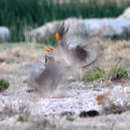Biology
provided by Arkive
In April, male lesser prairie chickens compete for access to females via a lekking system. Males gather in a display ground known as a 'lek' and perform elaborate courtship displays before the female selects her mate (2). These displays involve inflating the red throat sacs, raising the neck and tail feathers and making short jumps into the air (2). Following mating, the male takes no further part in the care of his offspring. Females lay a clutch of 12 – 15 eggs in a nest hidden amongst the grass and incubate them for around one month (2).
Lesser prairie chickens feed on a variety of items including seeds, grain and insects in the warmer months (3). If the winter is particularly harsh, these birds will burrow into the snow to provide warmth (2).
Conservation
provided by Arkive
The lesser prairie chicken is protected within all states that it occurs in (3), and it is a Candidate Species for listing as Threatened on the U.S. Fish and Wildlife Service Endangered Species Act (4). Research into the causes of recent population declines is being undertaken (2). Reintroduction programmes have also been attempted but so far have proven unsuccessful (3).
Description
provided by Arkive
The lesser prairie chicken is a gamebird that occupies the American prairies. It is a sandy colour with brown barred markings (2). There are yellow wattles of bare skin above the eyes (3). The red air sacs on the side of the throat are particularly prominent in males, who also have longer neck-plumes (3). The pale colours provide camouflage in the sandy grasslands of their habitat (2).
Habitat
provided by Arkive
Inhabits prairie grasslands where there is shinnery oak (Quercus havardii) or sand sagebrush (Artemisia filifolia) (3).
Range
provided by Arkive
The lesser prairie chicken still occurs in much of its former range including Kansas, Colorado, Oklahoma, Texas and New Mexico, United States (2). Population numbers have declined by as much as 97% since the beginning of the 19th century (2).
Status
provided by Arkive
Classified as Vulnerable (VU) on the IUCN Red List 2002 (1).
Threats
provided by Arkive
The conversion of vast areas of the American plains into farmland has caused the decline of a number of native species, including the lesser prairie chicken (2). These birds were also hunted in unsustainable numbers in the early 20th century and reduced populations are more vulnerable to extreme weather conditions such as drought (3).

